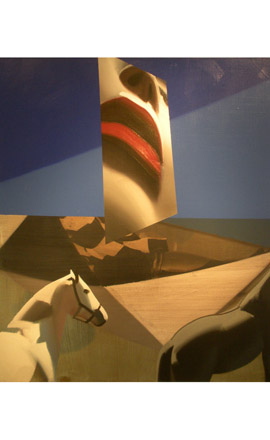
The current exhibition at the Pamela Williams Gallery in Amagansett, “The Dog and Pony Show,” is bound to strike some interesting chords among viewers. Negative reactions can be traced, for the most part, to preconceptions many undoubtedly have about the pictorial seriousness of the theme, not to mention the meaning of the phrase itself, when not applied to a specific art exhibition.
This was the initial response of just about everyone to whom I’ve spoken about the exhibit; indeed, many of them affected an air of benign derision, presumably based on prior exposure to art featuring dogs or horses that has been limited to bad Western paintings at tourist trading posts along the interstate highways, or the iconographic dogs playing poker on black velvet. (Their appraisal of the latter might change, considering that a 1903 original of this work by Cassius Marcellus Coolidge sold in 2008 for $193,000.)
As a result, what is typically overlooked—as a result of general knowledge only of truly abysmal art using horse and dog images—is the overall historical significance of these animals in the realm of art down through the ages. Starting with their appearance in the cave paintings in Lascaux and continuing up to the 20th century in works by Franz Marc, Pablo Picasso, and Roy Lichtenstein, both have appeared as subjects for innumerable artists. Still, the genre is seemingly always overshadowed by people’s memories of bad portraits of deceased family pets or of one of George Rodrigue’s paintings from his “Blue Dog” series.
When one understands, though, that these animals are often used by serious artists as metaphorical models for the powerful emotional relationships that exist between man and nature, then it becomes easier to see how the genre can transcend the sappier and more nostalgic connotations that it so often seems to hold for most audiences.
This is particularly true of works such as Paton Miller’s “Oh Please, Please” (mixed media on paper), in which the submissive pose of the three dogs is as much about insatiable desire and psychological manipulation as it is about begging for food. Derek Buckner’s “Confrontation #3 (oil on panel), meanwhile, illustrates the establishment of a Darwinian social structure that is as formulated and hierarchical as one would find at any Hamptons cocktail party.
Ivan Kustura’s “Fourth of July” (oil on canvas), on the other hand, uses horses within the composition as narrative components that gain power from their juxtaposition with both the sensually floating human figuration and the gentle geometric configuration of the picture plane.
In a similar vein, while not necessarily quite as sensual, David Suter’s “Wolf Moon” (wood, mirrored glass, and polychrome) is nevertheless deceptively romantic in a surprisingly whimsical manner, while Bill King’s “The Facts” (aluminum) is equally as fanciful, if also a bit more overtly suggestive.
The same might be said of Pete Turner’s “French Dressing” (archival pigment print, 1999), which is pictorially ambiguous enough to be perceived as either a manifestation of equine beauty or as a centerfold for Mr. Ed and Secretariat’s stalls at the stable.
Connie Fox, by contrast, uses canine images as contrasting elements that serve to anchor the picture plane and offset her use of a powerfully energetic rush of colors and brush strokes. Creating an ambiguous narrative that arises from within the abstract imagery itself, the work is by turns dynamically frenzied and gently restrained.
Interestingly, a similar statement could be made concerning the photographs of Ken Robbins, which seem to veer between moments of profound activity, as in “Bareback Bronc Rider” and “Saddle Bronc Rider,” or bucolically soft and melodic reveries, as in “Entre Chien et Loup” and “Bay Riders” (all archival digital prints).
Also of interest are Ralph Carpentier’s “Dog Park I” (oil on linen, 2009) and “Walking the Dog” (oil on linen 2008), each of which is more about the atmospherics of place than the figures themselves; Denise Regan’s “Bird, Book and Bowl” (mixed media on canvas, 1999), with its dynamic mix of color, pattern, and structure; and Charles Waller’s “Dogmatic” (hand-colored print on handmade paper), which manages to seem both entertainingly capricious and gently subversive at the same time.
Also featured in the exhibition at the Pamela Williams Gallery, which continues through May 10, are Kim Boulukos and John Handy.